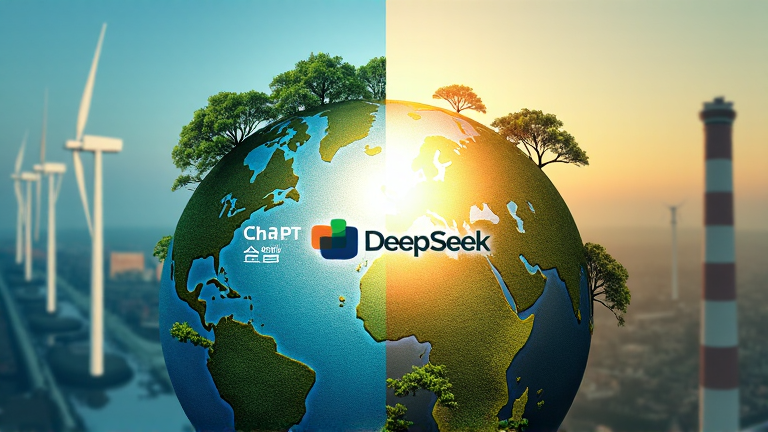
Evaluating the Environmental Footprint of AI: ChatGPT and DeepSeek
In the realm of artificial intelligence innovation, ChatGPT by OpenAI stands out as a well-known entity, celebrated for its impressive ability to deliver cohesive and contextually accurate answers. Originating from a collaboration with Microsoft, ChatGPT has redefined online research and fueled discussions surrounding AI's expanding presence in daily life.
On the horizon is DeepSeek, an emerging AI-powered challenger from China designed to be more energy-efficient and tailored for non-English speakers. Despite its relative obscurity compared to ChatGPT, DeepSeek invites curiosity as an open-source competitor on the global AI stage. However, amidst evaluations of functionality, adoption, and possible geopolitical implications, one critical aspect often overlooked is the sustainability of these AI models.
The Genesis of ChatGPT and DeepSeek
ChatGPT saw an exponential rise in late 2022, driven by its scalable deployment on Microsoft's Azure cloud services. Every advancement in the GPT model architecture, however, is accompanied by significant environmental implications, primarily due to the extensive computing power required, raising concerns about its carbon footprint.
DeepSeek, while not a household name compared to ChatGPT, is crafted to be a more streamlined and multilingual option. By utilizing strategies like pruning, model distillation, and enhancing algorithms, DeepSeek aims to reduce resource consumption and associated costs. The underlying belief is that requiring fewer GPUs should theoretically lead to lower energy use, though comprehensive data on its environmental footprint is still needed.
Energy Consumption and Carbon Output
One of the most significant environmental challenges faced by both models is the substantial energy required for training. Initial estimates indicate that deploying GPT4 for ChatGPT involved an extensive use of high-capacity GPUs over several weeks. In contrast, DeepSeek asserts that it utilizes fewer advanced chips, which potentially implies less electricity demand.
Data Centers and Energy Utilization
Operating ChatGPT on the Azure platform presents both benefits and challenges. While Microsoft is investing heavily in achieving a carbon-negative status by 2030 through renewable energy initiatives, many data centers continue to rely on non-renewable sources. Additionally, producing advanced AI chips is resource-demanding.
DeepSeek's reliance on Alibaba Cloud—China’s leading cloud provider—aligns with similar goals of carbon neutrality. However, the enduring dependence on coal in China’s national grid means a potentially significant environmental impact unless efforts focus on regions abundant in renewable energy. Despite this, DeepSeek’s emphasis on efficiency might ultimately result in reduced carbon emissions.
Water Utilization and Cooling Methods
The cooling of large GPU clusters to manage heat generation often involves substantial water usage, especially in warmer climates. Microsoft has faced scrutiny over its water usage practices, particularly concerning AI operational cooling.
Details about DeepSeek’s water footprint are sparse. If Alibaba Cloud’s modern data centers employ advanced cooling technologies, like immersion cooling, DeepSeek might demonstrate a more sustainable water management strategy. Still, without comprehensive and public data, accurate comparisons with ChatGPT remain challenging.
The Challenge of E-Waste
The rapid evolution of AI hardware, such as GPUs, can lead to fast obsolescence, contributing to increased e-waste—a concern linked to ChatGPT’s reliance on cutting-edge technology. Meanwhile, DeepSeek’s more economical approach could hint at slower hardware turnover and potentially reduced e-waste. Nonetheless, transparency regarding its hardware setup is essential to validate these assumptions.
Future Stances and Implications
At first glance, OpenAI’s partnership with Microsoft might offer ChatGPT a pathway to benefit from environmental conscientiousness—assuming that Microsoft’s ambitious sustainability goals translate into actual progress. In contrast, DeepSeek must contend with China's coal-reliant energy landscape, although its focus on energy efficiency may allow it to limit energy consumption per operation.
The reality is that neither the U.S., with Microsoft's sustainability pledges, nor China, depending heavily on coal, is a paradigm of clean energy. The political landscape, and its influence on energy policies, adds another layer of complexity to AI’s environmental ambitions.
In conclusion, while AI’s progress seems inexorable, the environmental considerations demand greater attention and transparency. The ongoing conversation regarding AI's energy use, water requirements, and hardware sustainability must intensify across all countries involved in training and deploying these systems. AI's trajectory towards an integral societal role necessitates a parallel commitment to its ecological implications, ensuring sustainability remains at the forefront of technological advancement.
Note: This publication was rewritten using AI. The content was based on the original source linked above.